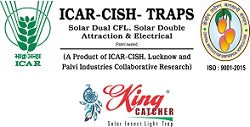Yellow stem borer
SCIRPOPHAGA INCERTULAS :
HOST CROP : Rice
DESCRIPTION
The yellow stem borer is a pest of deepwater rice. It is found in aquatic environments where there is continuous flooding. Second instar larvae enclose themselves in body leaf wrappings to make tubes and detach themselves from the leaf and fall onto the water surface. They attach themselves to the tiller and bore into the stem.
LIFE CYCLE
Eggs are laid on the upper leaf surface in masses of 15-80 and are covered with buff-colored hairs. The number of eggs laid by a single female moth is up to 150. Eggs hatch in about 5-10 days. The instar larvae get dispersed with the help of silken threads and wind. Then they bore into the rice stem. The larvae feed on the internal tissues of the stem and undergo 5-6 molts. A fully grown larva is formed in about 20- 40 days depending upon the climatic conditions. A developed larva measures about 20 mm in length and is white or yellowish-white in color. The larva makes an exit hole and pupates within the larval tunnel, usually at the base of the plant. The pupates is silky white in appearance. It remains in the pupal stage for 6-12 days (may prolong up to a month in certain seasons). Generally, two or three generations of this pest is completed during a single crop.
PEST IDENTIFICATION
The forewing of the female YSB moth is ochreous yellow to whitish with a black spot in the middle. It has a wingspan of 24-36 mm. Its abdomen is wide anal tufts are pale ochreous. The adult male is smaller than female. The forewings are gray or light brown in color and have two rows of black spots at the tip. Sometimes the males are whitish yellow and spots on the forewing are not very clear. Variation in the intensity of color in the forewing and the size of the moth has also been observed.
DAMAGES
Egg are laid on the underside of the leaves, freshly hatched larvae move downwards to leaf sheath and feed on inner tissue, With the advancement of growth and development larvae bore into stem bore into stem and feed on inner surface. Due to such feeding at vegetative stage the central leaf whorl unfold, turns brown and dries up which is termed as Dead Hearth. Infestation after the panicle initiation result in drying of panicle which may not emerges at all and those that have already emerges do not produce grain and appears as white head
TECHNOLOGY
Insect Sex Pheromone Technology. It is the process of attraction, and trapping the insect those damages to crops.
PER ACRE USE
Funnel trap with YSB lure at 15/ha for controlling.
PRECAUTION
Please use hand gloves / clean hand for handling lure
BENIFITS
• Economically Affordable, easy to install and manage.
• If used properly can detect low numbers of insects
• Collect only Species Specific
• Non toxic
• Can be used all season long
• Pheromone Lure is species-specific
• Reduce the use of harmful pesticide and do organic farming and save the life
PURE
Pheromone used 99% pure.
PRODUCT
100% Effective from other commercial product
WEATHER
Lure working Depend on weather conditions
PACKAGE
Packing signal unit in anti smell realizing pouch
LIFE
Lure working day in field life 30- 45 days
DISPENSER
silicon rubber Septa
DURABLE
Lure can stay for one year without removing from packing..



